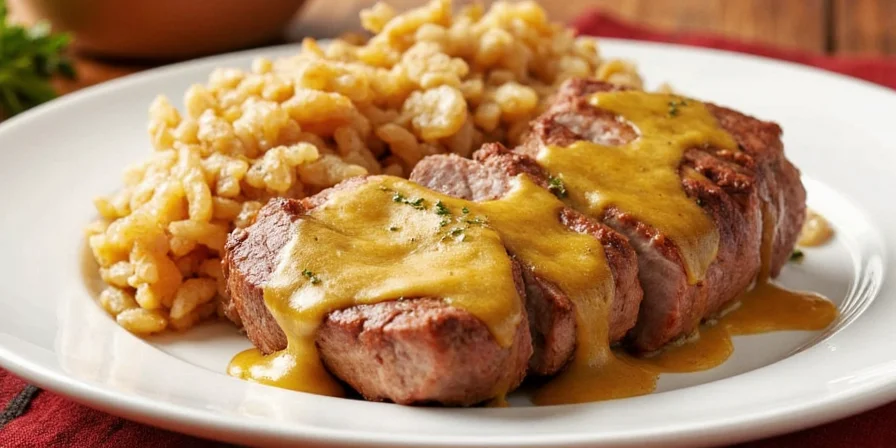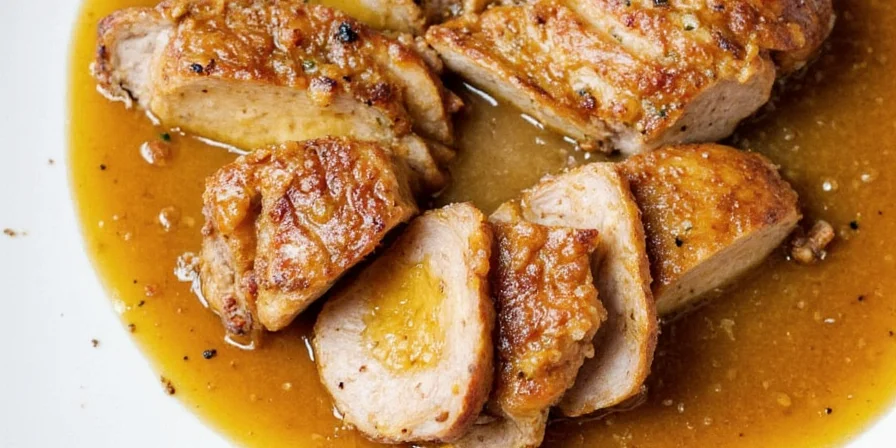Spice Up Your Grill: Mastering Mustard Marinade for Pork Loin
Are you tired of boring, bland pork loins? Do your weekend BBQs feel more like meaty monotony than flavor fireworks? Fear not—your pork-saving marinade has arrived. And it’s got mustard written all over it. Not just any mustard—this is the holy grail of mustard marinade for pork loin, and today, we’re serving up secrets, science, and a little bit of spice magic.
Why Mustard? The Secret Sauce You’ve Been Missing
If you thought mustard was just that yellow stuff squished between two slices of bread in a childhood sandwich, think again. Mustard is a flavor powerhouse with a pH level that tenderizes, a tang that brightens, and a viscosity that holds onto other spices like they're long-lost friends.
- pH Power: Mustard sits around 3.5–4.0 on the pH scale, making it perfect for breaking down muscle fibers without turning your meat into mush.
- Binding Buddy: Thanks to its thick texture, mustard clings to every nook and cranny, acting as a glue for herbs, garlic, and whatever secret ingredients you keep in your pantry.
- Flavor Amplifier: Mustard doesn’t shout—it whispers complexity and enhances everything else in the mix.
The Golden Ratio: Crafting the Perfect Mustard Marinade
Like any great recipe, balance is key. Too much mustard, and you’ll taste nothing but tang. Too little, and you miss out on the full symphony of flavor. Let’s break it down into a foolproof formula anyone can follow:
| Ingredient | Function | Recommended Type | Quantity per 1 lb Pork |
|---|---|---|---|
| Dijon Mustard | Tang & Binding | Grey Poupon or Maille | 2 tablespoons |
| Honey or Maple Syrup | Balancing Sweetness | Local raw honey preferred | 1 tablespoon |
| Garlic (minced) | Aroma & Depth | Fresh cloves, not jarred | 2 cloves |
| Olive Oil | Moiosture & Heat Protection | Extra Virgin Olive Oil | 1 tablespoon |
| Paprika or Smoked Chipotle | Smoky Heat | Pimentón de la Vera | 1 tsp |
This blend gives you the right balance of sweet, sour, umami, and heat—all while letting the pork shine. Now let’s talk application techniques!
Application Tips That Make a Difference
You’ve got the marinade—now how do you use it? Here are some pro-level tips to make sure every bite is bursting with flavor:
- Marinate Overnight: Even 4 hours helps, but 8–12 hours gives flavors time to really sink in.
- Massage Like a Pro: Use your hands. Seriously. Rub that marinade in like you’re giving your pork a spa treatment.
- Vacuum Seal for Penetration: If you have one, a vacuum sealer ensures maximum absorption and even coating.
- Rest Before Slicing: Don’t slice too soon after cooking. Rest for at least 5–10 minutes to lock in juices.
- Grill with Indirect Heat: To avoid charring the surface before the center cooks, use indirect grilling techniques.

Marinade Variations: Customize Like a Chef
Once you've mastered the basic mustard marinade, it's time to play. Here are a few fun twists to try depending on your mood or the occasion:
- Asian Fusion: Add soy sauce, sesame oil, and a splash of rice vinegar. Top with toasted sesame seeds before serving.
- Southern Style: Mix in a dash of apple cider vinegar, brown sugar, and cayenne pepper. It’s BBQ heaven in a bowl.
- Herbaceous Dream: Stir in fresh rosemary, thyme, and a touch of lemon zest. Roast low and slow for Sunday dinner vibes.
- Citrus Kick: Swap honey for orange marmalade and add lemon juice and zest. Bright, bold, and citrusy.
- Heat Lover’s Special: Toss in habanero sauce or crushed red pepper flakes for a fiery finish.
Science of Spice: Why Mustard Works So Well
Let’s get a little geeky for a second. Why does mustard work so well with pork? It’s all about the chemical compounds. Mustard contains allyl isothiocyanate—the same compound found in horseradish and wasabi—that stimulates saliva and gastric juices. This makes food more flavorful and digestible.
Additionally, mustard seeds contain proteins and mucilage, which help emulsify fats and liquids, creating a smoother mouthfeel and more consistent coating on the meat.
So when you slather on that mustard marinade, you're not just adding flavor—you're activating an entire sensory experience that starts in your nose and ends on your tongue.
Storage & Safety: Keep Your Marinade Fresh and Safe
While marinating is a great way to boost flavor, safety should never be compromised. Here’s what you need to know:
- Always refrigerate: Never leave meat marinating at room temperature—it’s a breeding ground for bacteria.
- Use within 24 hours: While some marinades can sit longer, acidic components like mustard can begin to cook the surface of the meat if left too long.
- Don’t reuse marinade: Unless you boil it first, leftover marinade from raw meat shouldn’t be reused due to cross-contamination risks.
- Label and date: If you prep multiple marinades, label them clearly to avoid confusion later.
FAQ: Common Questions About Mustard Marinades
Can I substitute regular yellow mustard?
Yes, but expect a less intense flavor. Dijon is sharper and silkier, while yellow mustard leans sweeter and thinner.
How long can I store unused marinade?
If sealed and refrigerated, most homemade mustard-based marinades last up to 5 days. Store in a glass jar for best results.
Can I freeze it?
Absolutely. Pour the marinade into ice cube trays, freeze, then transfer to a ziplock bag. Use one cube per pound of meat—easy peasy.
Should I rinse off the marinade before cooking?
Nope! Let it stay on. Rinsing washes away flavor and prevents proper browning.

Pro Pairings: What to Serve With Mustard-Marinated Pork
You’ve gone through all this trouble to make a killer mustard marinade—don’t pair it with soggy fries. Elevate your plate with these sidekick suggestions:
- Apple Slaw: Thinly sliced apples, mayo, apple cider vinegar, and a pinch of cinnamon. Tangy meets tangy.
- Roasted Root Vegetables: Carrots, parsnips, and beets tossed with olive oil and thyme. Earthy sweetness pairs perfectly.
- Herbed Mashed Potatoes: Garlic mashed potatoes with chopped parsley and green onions. Creamy and comforting.
- Crusty Baguette: A warm slice of crusty bread to soak up any extra marinade or juices.
- Beer or Wine Pairings: Try a Belgian Witbier, crisp Sauvignon Blanc, or light-bodied Pinot Noir.
Conclusion: Mustard is More Than Just a Condiment
At the end of the day, mastering the art of mustard marinade for pork loin isn’t just about following a recipe—it’s about understanding flavor profiles, ingredient chemistry, and a little culinary creativity. Whether you’re a seasoned chef or backyard griller, mustard offers endless possibilities to elevate your meat game.
From tenderizing to binding to boosting depth, mustard proves it’s more than a condiment—it’s a kitchen MVP. So next time you reach for the salt and pepper, don’t forget to give the jar of golden goodness a spin too.
Now go forth, season boldly, and enjoy the juiciest, most flavorful pork loin of your life!











 浙公网安备
33010002000092号
浙公网安备
33010002000092号 浙B2-20120091-4
浙B2-20120091-4